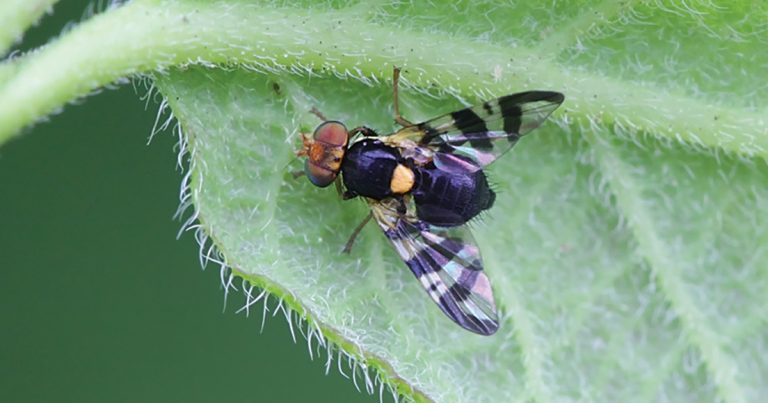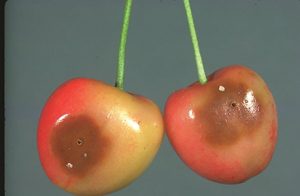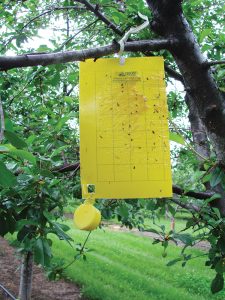Free printed copies of pest alerts are available.
Origin and Distribution
The European cherry fruit fly, Rhagoletis cerasi (Linnaeus) (Diptera: Tephritidae), is a new invasive insect to North America. Its first confirmation in North America was in an urban park in Mississauga, Ontario in June 2016. The likely mode of entry was in imported fresh cherries or other host plant material. This pest occurs throughout most of continental Europe and central and western Asia, and is the most economically important pest of sweet cherries in Europe. It exclusively attacks the fruit of host plants. European cherry fruit fly has not yet been detected in the U.S., although it has been intercepted more than 100 times at U.S. ports of entry (58 interceptions since 2000), with all interceptions occurring on Prunus spp. fruit found in passenger baggage.

Identification and Life History
Adults are 4 to 5 mm long, slightly smaller than a house fly. The body is black with yellow markings on the head and thorax, and transparent wings with four characteristic bluish-black bands. Larvae are creamy-white, legless, and shaped like a typical fruit fly larva: tapered at the head and rounded at the tail. Third (last) instar larvae can reach up to 6 mm in length. Pupae are pale yellowish-brown and 3 to 4 mm in length. The European cherry fruit fly is a close relative of other Rhagoletis species in North America, including native cherry-infesting species such as the eastern cherry fruit fly (R. cingulata), the black cherry fruit fly (R. fausta), and the western cherry fruit fly (R. indifferens). It can be readily distinguished from related species by adult morphology, mainly wing banding patterns.
European cherry fruit fly has one generation per year. It overwinters as a pupa in the soil underneath or near the host plant and emerges as the fruit ripens. Adults are most active from late May to early July when conditions tend to be warm and dry, and can live 16 to 35 days, depending on temperatures. Mated females use their ovipositor to insert eggs into ripening fruit and prefer fruit that are in full sun. Females usually lay only one egg per fruit, just beneath European Cherry Fruit Fly the skin, and can lay 30 to 200 eggs in their lifetime. Eggs hatch in one to two weeks, and the larvae feed on the flesh of developing fruit for four to six weeks. Mature larvae exit the fruit and drop to the ground to burrow into the soil and pupate. The native Rhagoletis species are similar in biology and life history to the European cherry fruit fly.


Plant Hosts
Cherry is a major host of the European cherry fruit fly, including sour cherry (P. cerasus), sweet cherry (P. avium), black cherry (P. serotine), mahaleb cherry (P. mahaleb), European bird cherry (P. padus), almond cherry (P. glandulosa), bunge cherry (P. humilis), and European dwarf cherry (P. fruticosa). Other known host plants include bloodtwig dogwood (Cornus sanguinea), holly-leaved barberry (Mahonia aquifolium), matrimony vine (Lycium barbarum), snowberry (Symphoricarpos albus), coralberry (S. orbiculatus), garden snowberry (S. rivularis), whortleberry (Vaccinium myrtillus), and several types of honeysuckle (Lonicera spp.). In Ontario, adult detections have been associated with Morrow’s honeysuckle (L. morrowii), Tartarian honeysuckle (L. tartarica), and Bell’s honeysuckle (L. xbella), indicating that honeysuckle should be included as a sentinel host plant in future detection efforts. While the European cherry fruit fly has not yet been found in the U.S., its predicted geographic range includes USDA plant hardiness zones 2 through 10.
Damage
Adult females prefer to deposit eggs in fruits when they first begin to ripen and are yellow to pink-yellow in color. Injury to fruit is caused by oviposition scars, but primary damage is due to larval feeding, defecation, and tunneling in the fruit flesh. Infested fruit may soften prematurely, develop brown spots, wilt or shrivel, and fall off the tree. Exit holes become visible as larvae vacate the fruit. Feeding damage can result in fruit losses of up to 100% if left uncontrolled.

Monitoring and Management
An effective monitoring tool is a yellow sticky card baited with an ammonium acetate or carbonate lure. Traps should be placed in the fruiting canopy of the tree, shortly after bloom and before the fruit start to ripen and become susceptible. Research has shown that adult captures are higher in traps placed in the sunny or southern part of the tree canopy. Sweep netting can also be used to survey for European cherry fruit fly in shrubs and lower growing hosts, such as honeysuckle.
Important cultural controls that growers can implement to prevent or minimize European cherry fruit fly outbreaks include maintaining a clean orchard by removing dropped fruit from the orchard floor and removing wild and abandoned host trees. Additionally, covering the soil under the tree canopy with ground cover, weed barrier fabric, or mulches will help prevent larvae from burrowing into the soil or emerging adults from exiting the soil.
If you suspect you have encountered the European cherry fruit fly, contact your State Department of Agriculture, University Diagnostic Laboratory, or Cooperative Extension Service. Specimens should be collected and accurately identified by an expert.

Credits
Authors: Lori Spears and Diane Alston, Department of Biology, Utah State University
This work is supported by the Crop Protection and Pest Management Program (2014-70006-22486) from the USDA National Institute of Food and Agriculture.
For information about the Pest Alert program, please contact the North Central IPM Center at northcentral@ncipmc.org.

